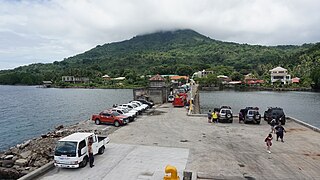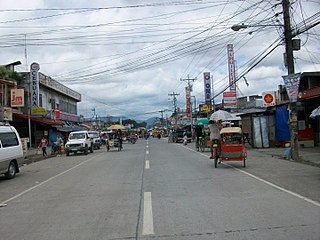
Guinsiliban, officially the Municipality of Guinsiliban, is a 6th class municipality in the province of Camiguin, Philippines. According to the 2015 census, it has a population of 6,281 people.

Dangcagan, officially the Municipality of Dangcagan, is a 3rd class municipality in the province of Bukidnon, Philippines. According to the 2015 census, it has a population of 23,723 people.

Impasugong, officially the Municipality of Impasugong, is a 1st class municipality in the province of Bukidnon, Philippines. According to the 2015 census, it has a population of 47,859 people.

Kibawe, officially the Municipality of Kibawe, is a 2nd class municipality in the province of Bukidnon, Philippines. According to the 2015 census, it has a population of 39,612 people.

Kitaotao, officially the Municipality of Kitaotao, is a 1st class municipality in the province of Bukidnon, Philippines. According to the 2015 census, it has a population of 50,260 people.

Libona, officially the Municipality of Libona, is a 1st class municipality in the province of Bukidnon, Philippines. According to the 2015 census, it has a population of 43,969 people.

Manolo Fortich, officially the Municipality of Manolo Fortich, is a 1st class municipality in the province of Bukidnon, Philippines. According to the 2015 census, it has a population of 100,210 people.

Pangantucan, officially the Municipality of Pangantucan, is a 1st class municipality in the province of Bukidnon, Philippines. According to the 2015 census, it has a population of 53,126 people.

San Fernando, officially the Municipality of San Fernando, is a 1st class municipality in the province of Bukidnon, Philippines. According to the 2015 census, it has a population of 56,138 people.

Aloran, officially the Municipality of Aloran, is a 4th class municipality in the province of Misamis Occidental, Philippines. According to the 2015 census, it has a population of 27,625 people.

Panaon, officially the Municipality of Panaon, is a 5th class municipality in the province of Misamis Occidental, Philippines. According to the 2015 census, it has a population of 10,209 people.

Sinacaban, officially the Municipality of Sinacaban, is a 5th class municipality in the province of Misamis Occidental, Philippines. According to the 2015 census, it has a population of 18,391 people.

Lala, officially the Municipality of Lala, is a 1st class municipality in the province of Lanao del Norte, Philippines. According to the 2015 census, it has a population of 67,727 people.

Alubijid, officially the Municipality of Alubijid, is a 4th class municipality in the province of Misamis Oriental, Philippines. According to the 2015 census, it has a population of 29,724 people.

Binuangan, officially the Municipality of Binuangan, is a 6th class municipality in the province of Misamis Oriental, Philippines. According to the 2015 census, it has a population of 7,515 people.

Gitagum, officially the Municipality of Gitagum, is a 5th class municipality in the province of Misamis Oriental, Philippines. According to the 2015 census, it has a population of 16,373 people.

Lagonglong, officially the Municipality of Lagonglong, is a 5th class municipality in the province of Misamis Oriental, Philippines. According to the 2015 census, it has a population of 21,659 people.

Libertad, officially the Municipality of Libertad, is a 5th class municipality in the province of Misamis Oriental, Philippines. According to the 2015 census, it has a population of 12,354 people.

Sugbongcogon, officially the Municipality of Sugbongcogon, is a 5th class municipality in the province of Misamis Oriental, Philippines. According to the 2015 census, it has a population of 9,226 people.

Talisayan, officially the Municipality of Talisayan, is a 4th class municipality in the province of Misamis Oriental, Philippines. According to the 2015 census, it has a population of 24,505 people.
























